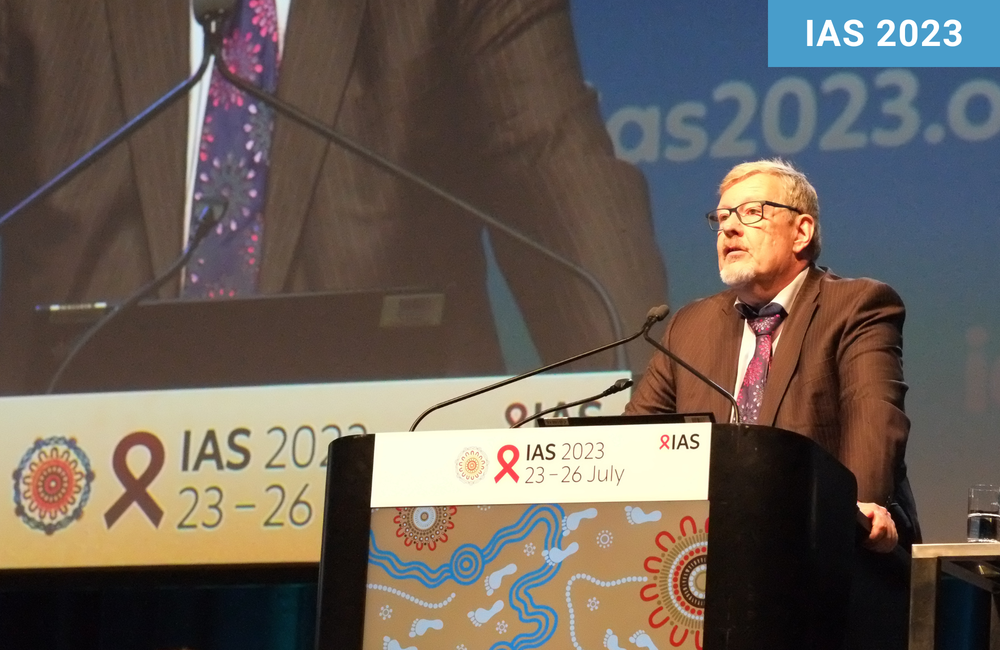
A combination of the non-nucleoside reverse transcriptase inhibitor doravirine and the experimental antiretroviral islatravir proved just as effective as the combination of bictegravir, emtricitabine and tenofovir alafenamide (Biktarvy) in suppressing HIV in previously untreated people after 48 weeks of treatment, Professor Jürgen Rockstroh of the University of Bonn reported at the 12th International AIDS Society Conference on HIV Science (IAS 2023) in Brisbane, Australia, on Monday.
Islatravir is the first drug of a new class called nucleoside reverse transcriptase translocation inhibitors (NRTTIs). Developed by Merck, islatravir is being studied in several potential combinations. The drug persists in cells for much longer than any other antiretroviral and early development of islatravir included studies of high doses given once a week. Clinical development of islatravir was paused in November 2021 after the discovery that people taking higher doses of the drug in clinical trials had experienced falls in white blood cells (including CD4 lymphocytes). These changes were dose-related and development of islatravir resumed using lower doses.
A phase 2b dose-ranging study that compared daily doses of 0.25mg, 0.75mg and 2.25mg found that doses of 0.75mg and 0.25mg resulted in equivalent rates of viral suppression when combined with doravirine. The 0.75mg dose was initially taken forward for larger phase 3 studies but after the development pause, Merck decided to focus on testing a 0.25mg dose of islatravir.
Today, Professor Rockstroh presented results of the phase 3 study that tested the 0.75mg dose of islatravir combined with doravirine, which was almost fully recruited when islatravir development was paused in December 2021.
The MK-8591A-020 study recruited previously untreated adults with HIV with detectable viral load above 500 copies/ml. The study excluded people with hepatitis B or any major drug resistance mutations to any class of antiretroviral. The study recruited 597 people in 13 countries (32% in Europe, 22% in North America, 23% in Latin America and 18% in South Africa).
The study population was predominantly male (approximately 75% in each study arm) and just over half of participants (57%) were White. Twenty per cent of participants had CD4 counts below 200 and 18% in the doravirine/islatravir arm and 20% in the bictegravir arm had a baseline viral load above 100,000.
Study participants were randomised to receive either 100mg of doravirine and 0.75mg of islatravir once daily or bictegravir, emtricitabine and tenofovir alafenamide (Biktarvy) once daily. Participants also took placebo pills so that they could not guess which combination they had been assigned to.
The primary endpoint of the study was the proportion of participants with viral load below 50 at week 48. The study showed that viral suppression in the doravirine/islatravir arm was statistically non-inferior to the Biktarvy arm. There was no significant difference in viral suppression at week 48; 88% in each study arm had viral load below 50. Two per cent in the doravirine/islatravir arm and four per cent in the bictegravir arm had viral load above 50, with no virological data available for the remaining participants at week 48.
Five participants experienced virological rebound above 200 or an incomplete response to treatment. One participant with high baseline viral load (above 1 million) and adherence difficulties did not achieve viral suppression during the study and had detectable drug resistance. Resistance testing detected doravirine resistance and the M184I NRTI mutation, which causes resistance to islatravir. The M184I mutation was associated with a fourfold reduction in susceptibility to islatravir but this was not classified as resistant by the study investigators.
Asked whether this finding suggests a higher risk of drug resistance if the lower 0.25mg islatravir dose is used, Professor Rockstroh said although pharmacokinetic modelling did not show a difference between the 0.25mg and the 0.75mg study doses that might lead to a higher risk of treatment failure at the lower dose, “that is one of the big questions of the ongoing phase 3 studies.”
Participants in both study arms experienced CD4 cell count increases. The mean increase was greater in the bictegravir arm at week 48 (+234 vs +184). There was no significant increase in total lymphocyte count in the doravirine arm during the study, whereas the total lymphocyte count increased in the bictegravir arm. The study protocol required that participants should withdraw from the study for treatment optimisation if they experienced a 30% reduction in total lymphocyte count or a CD4 decline below 200. Sixteen participants in the doravirine/islatravir arm and six in the bictegravir arm discontinued due to CD4 or total lymphocyte decreases.
One study participant in the doravirine/islatravir arm died of pneumocystis jirovecii pneumonia but this was not considered to be treatment-related, as it occurred early in the study, Professor Rockstroh said.
There was no significant difference in grade 3 or 4 toxicity (10% vs 11%) and only two participants withdrew from the study due to drug-related adverse events (both in the bictegravir arm). There was no difference in the frequency of drug-related adverse events, each occurring in less than 10% of participants (headache, diarrhoea, insomnia or weight increase). Participants in each study arm gained approximately 3.5kg in weight by week 48.
A phase 3 study is now comparing doravirine and a lower islatravir dose of 0.25mg to Biktarvy in previously untreated people. Recruitment to the MK-8591A-053 study is ongoing and the trial is expected to report primary outcome data in 2025.
Rockstroh JK et al. Doravirine/islatravir (100mg/0.75mg) once daily compared to bictegravir/emtricitabine/tenofovir alafenamide (B/F/TAF) as initial HIV-1 treatment: 48 week results from a double-blind phase 3 trial. 12th IAS Conference on HIV Science (IAS 2023), Brisbane, abstract OALBX0102, 2023.
